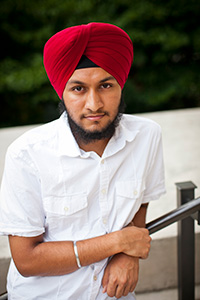
Kulpreet Chilana
“I’m really passionate about bringing my culture into technology, “ says Chilana, who grew up speaking both English and Punjabi. As a high school freshman, he taught himself to read and write in Hindi, India’s official language, and Urdu, the lingua franca of Pakistan. “It was really interesting to see how certain aspects of the Urdu, Hindi and Punjabi cultures were different, but the structure and everything is so similar.”
The experience prompted Chilana to create his first app, a Punjabi-English dictionary. The app translates English words into Punjabi, which are written in the Indian and Urdu script — a small but meaningful detail that blends language elements from India and Pakistan. “It’s a subtle thing,” he says. “It’s sort of promoting harmony between the two regions ... and I thought, this is really unique.”
Chilana released the app on iTunes, then set up a nonprofit foundation to donate the proceeds to two charities in India: a school for the handicapped and a small village school that his father attended as a child. Over three years, Chilana made more than $15,000 in donations before closing the foundation after graduating high school.
What to do after graduation was a bit up in the air, he admits. Having inherited an entrepreneurial spirit from his father, a physician who runs a medical school in the Caribbean, Chilana was tempted to go the startup route. Friends had eschewed college for companies — one even dropping out of high school to work in Silicon Valley. The choice was difficult, says Chilana, whose high school classmates voted him “most likely to become a millionaire.” But the eager entrepreneur ultimately chose MIT, where he plans to study computer science.
“Overall, I feel like college is four years you can’t get later in life,” Chilana says. “Also, Cambridge has its own startup ecosystem, and MIT seemed like the best option, especially in terms of entrepreneurship.”
On campus, Chilana joins a select group of students in MIT’s Class of 2016. Among 18,109 applications, the Institute admitted 1,620 applicants — an acceptance rate of 9 percent. Of those accepted, 1,138 have enrolled, for a yield of 70 percent. The Class of 2016 is 54 percent male and 46 percent female, and ethnically diverse: 8 percent African-American, 28 percent Asian-American, 37 percent Caucasian, 15 percent Hispanic, and 10 percent citizens of foreign countries.
First-year students hail from most U.S. states (with California the most represented) and 54 nations (the freshman with the longest journey traveled from Perth, Australia). The majority of the 848 high schools represented by MIT’s Class of 2016 are public, with 16 percent private and 8 percent religious; 1 percent of the class was home-schooled.
A distraction becomes a passion
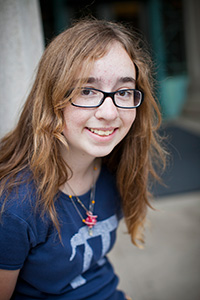
Megan Belzner
“When I was younger, I couldn’t really join my peers running around on the field outside, because it hurt too much,” Belzner recalls. “So I’d spend my time inside playing computer games. And I think I found something in computers that I really enjoyed, and it gave me a place to play around.”
Computer programming, which at first served as a distraction, has now become a passion for Belzner. And today, for the most part, her arthritis is manageable, although she’s quick to point out that not everyone is so lucky.
“I’ve responded well to the medications I’ve tried, so nowadays it doesn’t bother me so much,” Belzner says. “But a lot of people that I’ve met have awful side effects, or the medications just don’t work.”
To help other young people with the disease, Belzner became an advocate for the Arthritis Foundation and has traveled to Washington as part of a yearly advocacy summit to promote awareness of the disease and support for efforts to fight it.
Belzner is currently contemplating a project to program a computer to learn language “from the ground up,” on its own — a project she’s already started with a friend back home in New Mexico. “We’re starting with English,” Belzner says, “but we’re trying to make a system that could be applied to any language, or most languages.”
‘See and decide’
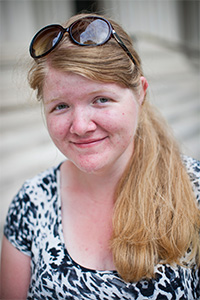
Eva-Lotta Käsper
In ninth grade, in part because of her interest in languages and in part at her friends’ insistence, Käsper joined a team participating in Estonia’s national linguistics Olympiad. “I hadn’t even heard of the word linguistics, but I thought, ‘If they’re going, I want to go, too,’” Käsper remembers. “I discovered that it’s really awesome and incredibly interesting.”
That first linguistics Olympiad led to others on the international level, which brought Käsper to South Korea, Spain, Poland, Sweden, the Ukraine, Turkey, Singapore and the United States. Returning to Estonia from those competitions, she brought with her a bit of hardware: a gold medal last year for linguistics, and this year, silver medals in linguistics and biology, and a bronze for chemistry.
Käsper says that one of the main reasons she applied to MIT was its cultural opportunities. “If I went to a European university, the cultural change for me wouldn’t be that big,” Käsper says. “Here it is a whole different world.”
She’s mulling over many possible majors — although she’s not pressuring herself to make a choice quickly. “Freshman year is for exploring everything,” Käsper says. “That’s one of the things I like about the university system in the U.S.: you don’t have to know when you come here; you get to see and decide.”
The big payoff
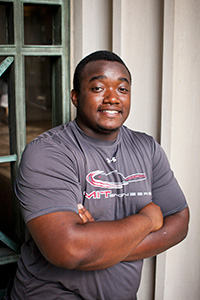
Luther Banner
“All of them are very supportive,” Banner says. “And everybody has a feeling of what everyone else is going through.”
Growing up in St. Louis, Banner found support in many team sports — in particular, a Little League team coached by his uncle. Banner never knew his father, who died before he was born. He was raised by his mother and grandmother, and says his uncle was a large and steady influence.
“My uncle was my coach growing up,” Banner says. “It was just good to have someone who could show me what’s needed to be a man.”
Banner continued playing baseball and then football in high school, joining his varsity football team in back-to-back state championship titles. But during his freshman year, an injury on the field waylaid him for the football season. To keep busy, at the suggestion of his physics teacher, Banner signed up for FIRST — an international robotics competition for high school students. The experience stoked his interest in robotics and engineering, and last year he won the competition’s Dean’s List Award for outstanding leadership.
In December, Banner received a shiny cylinder in the mail — an early-action acceptance letter, with balloons and confetti, from MIT. The package was the ultimate payoff for Banner.
“When you go in and work hard and you do what you have to do during practice, then you ultimately get a payoff in victories,” Banner says. “In school, it felt like it took forever for me to see the payoff from working as hard as I did for the past 12 years. So that was pretty overwhelming.”
Banner is excited about the research opportunities at MIT, and already has plans for his first project: football helmets. “I’d like to try to figure out if there’s a way there could be a better engineered helmet to slow concussions,” he says. “Just knowing there’s such a wide array of things I could do is really interesting to me.”
A different view

Colt Richter
But he says aeronautical and astronautical engineering also beckons, as flying has been in his family for generations: Richter’s grandfather was a pilot in World War II, and later became a commercial airline pilot, moving the family to Alaska after he secured a job with Japan Airlines. As a child, Richter flew small planes with his father and received his pilot’s license on his 17th birthday.
“I’ve kind of grown up around aviation,” Richter says. “We have a cabin about 50 miles from Anchorage that you have to fly to in order to get to. So my whole life I’ve been surrounded by it.”
Something else that surrounds Richter: Alaska’s towering mountain ranges, which he’s appreciated from a very young age. “I started downhill skiing when I was about 3,” Richter recalls; he more recently transitioned to competitive Nordic skiing as part of his high school ski team.
While he’s looking forward to a new beginning at MIT and living on his own, Richter says one of the things he’ll miss most about home is the view. “Here, I can look out my window and see mountains,” Richter said in a phone call from his Alaska home. “In Boston, it’s really, really flat.”
Rodeos and asteroids
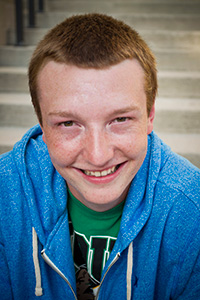
Jorrie Brettin
This sprawling landscape was a perfect setting for his father’s ranch work. For years, Brettin helped his dad raise and sell horses and bulls to the National Finals Rodeo, the largest championship rodeo event in the United States. “He was truthfully at the top of his game,” Brettin says proudly. “My dad is definitely a hardcore cowboy.”
Through his dad’s work, Brettin got an insider’s view of the rodeo world, and almost considered participating himself. “I was going to be a saddle-bronc rider,” Brettin says. “But I’m too tall, I’d be all over the place. It’d be a show, but I’d break my neck.”
Instead, Brettin developed an interest in computer science, which he admits stems from the video games he played after school. Wanting to learn more about computer programming, he looked online and found the Summer Science Program, a residential research program co-sponsored by MIT in which students live and work together to solve problems in astronomy, physics and computer science.
To qualify for the program, Brettin needed to take calculus, a course that was not offered at his public school. So in his junior year, he transferred to a school that offered the course, 20 miles away. The move and the class got him into the summer program, where he and other students spent the summer writing computer programs to predict the path of an asteroid. From their efforts, they found that an asteroid named 1036 Ganymed “is definitely going to run into the sun in 25 million years,” Brettin says. “So watch out for that.”
The summer program was a pressure-cooker experience that Brettin says he ultimately enjoyed — and he thinks may have been good preparation for MIT’s challenging, creative environment. “It was way different than my standard expectations or comfort level,” Brettin says. “You see everything differently … and that’s so cool.”
‘I want to be pushed to that level’
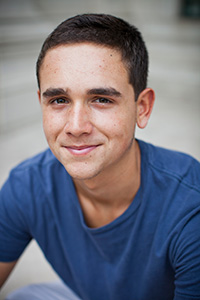
Demitri Nava
As a kid, Nava moved around a lot, going back and forth between his parents, who divorced when he was 3 years old. Complications at home gradually took a toll, and Nava recalls middle school as a listless time. “I started at this really low point,” he says. “I was pretty depressed, out of shape, and I didn’t really feel like I had meaning to what I was doing.”
It took a tragedy — the drowning of a close cousin when Nava was in eighth grade — for Nava to change his perspective. “It sort of brought me to the realization that I shouldn’t waste the time that I have,” Nava says.
He began exploring different interests. Nava had always played instruments in school, but never stuck with one until he took up the drums in high school. From then on, he signed up for any and all musical groups, from a jazz ensemble to an orchestra to his high school’s marching band. “It’s a big community,” Nava says of the marching band. “You understand not only how your instruments work together, but how you as people work together.”
Nava also took advantage of one of Santa Cruz’s best attractions: its waves. Last year, he learned to surf. Being on the board, he says, gives him balance. “It just puts me at peace,” Nava says. “There’s something about being on a board out on the ocean and just seeing the waves that brings me to a state of mind that’s almost unbeatable.”
When it came time to apply to college, friends encouraged him to apply to Questbridge, a nonprofit program that awards scholarships to high-achieving, low-income students to attend MIT and other leading U.S. universities. The MIT community, he says, is what he’s most looking forward to.
“It seems like at MIT, the kids have this focus and drive toward something they’re truly passionate about, and that’s something I want to be around,” Nava says. “I want to be around kids who want to be learning and inventing all the time, because I want to be pushed to that level.”
Editor’s note: The students profiled in this story represent those who responded to a query from MIT News. | Photos: Dominick Reuter






